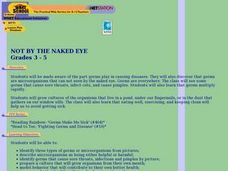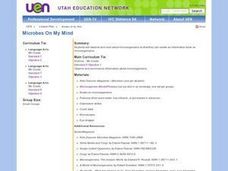Curated OER
What Does My Bacteria Look Like?
Students identify Gram positive and Gram negative bacteria using staining techniques. Students research importance of identification of bacterial types in diagnosing bacterial diseases.
Curated OER
Good Guys - Small Packages
Students read documentation about microorganisms in agriculture and share what they've read with partners. They taste samples of yogurt and describe the yogurt making process. They experiment with fermenting milk to recreate the yogurt...
Curated OER
Helpful Microorganisms
Students study how some microorganisms are helpful and practical in foods. They work with microorganism in a number of food, such as yeast in bread and yogurt.
Curated OER
The Good, the Bad and the Both
Middle schoolers use information from articles about microorganisms and their prior knowledge to identify both the positive and negative aspects of microorganisms.
Curated OER
Microbes on My Mind
Students observe and read about microorganisms so that they can create an information book on microorganisms.
Curated OER
Microbes 1: What's Bugging You?
Students build on existing knowledge of microbes, focusing on the relationship between microorganisms and foodborne illness, as well as the implications that foodborne illness has on human health.
Curated OER
Biological Succession in a Microecosystem
High schoolers investigate the concept of biological succession by simulating the process in a microenvironment with various microorganisms. By engaging in a lab, students determine the factors causing succession and learn population...
Curated OER
Microorganism Multiplication
Seventh graders complete two experiments to learn about harmful and helpful microorganisms. For this microorganisms lesson, 7th graders read background information about fungi, yeast, and club fungi. Students then complete two...
Curated OER
Spud Smear
Students study various samples of microorganisms in petri dishes. In this microorganism lesson, students place various samples of items in petri dishes and observe them after several days of incubation.
Curated OER
Going Places
For this going places worksheet, students read the passages provided and answer the given questions. Students answer questions as it relates to the skeletal system, puberty, and microorganisms.
Curated OER
Creatures in Torch Lake
Students investigate pond ecology. They gather water samples from various sources, add grass, and let it sit for a week. Afterward, using microscopes, they identify the microorganisms present in the sample.
Curated OER
Iron Bugs
Students describe how microbial metabolism affect geochemical processes. They define and explain the function of siderophores. They describe two ways bacteria utilize iron and explain why iron availability may limit biological activity.
Curated OER
Microbial Spoilers: The Impact of Microorganisms on the Shelf-life of Milk
Learners are inroduced to a commonly used microbial culturing technique. They explore the role of microorganisms in determining the shelf-life of food products.
Curated OER
MAPPING A RESEARCH SITE AND COLLECTING AND PRESENTING POPULATION DATA
Sixth graders are to answer research questions based on data they collect.
Curated OER
Our Food and Microorganisms
Learners answer questions about how microorganisms can affect our food supply and how they can be controlled. The first set of inquiry activities are directed by the teacher. Subsequent activities are based on students generating their...

















